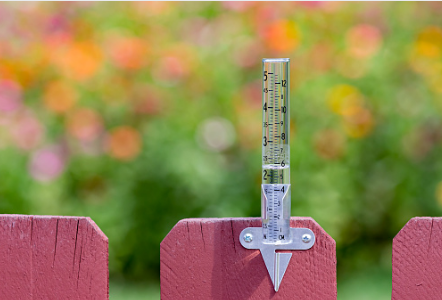Before purchasing a rain gauge, you should read this article to learn more about its working principle, capacity, and placement. This article will explain where to find the Standard United States National Weather Service rain gauge. This article also provides tips for installing your rain gauge. Hopefully, this information will help you choose the right one for your needs. In addition, you’ll learn how to read the data on your rain gauge and avoid buying an inaccurate one. This difference is due to the effect of wind. Additionally, the rain gauge should be located at least two meters off the ground because the rain will splash into the sensor if it is placed higher.
 Standard United States National Weather Service rain gauge
Standard United States National Weather Service rain gauge
A Standard United States National Weather Service rain gauge is a simple device that measures rainfall in a measuring tube. Its measuring stick, approximately 24 inches in diameter, is graduated every one-hundredth inch. You insert the measuring stick through the orifice in the collector funnel. Water will collect in the measuring tube and overflow into the smaller graduated cylinder. The height of the water in the smaller cylinder represents the total amount of rain falling.
Rain gauges have different capacities. The largest holds 20 inches of water, while the smallest is 0.3 inches. It is because snow melts on rain gauges, so the amount of water recorded is based on the water equivalent. However, it is not practical to determine snow depth using a rain gauge unless you shovel it. Using a rain gauge in such circumstances is unwise. You may not want to risk getting a substandard rain gauge.
Working principle
There are several types of rain gauges. Each one has a different working principle and method for recording rainfall. For example, tipping bucket types are based on recording humidity range versus time, while funnel-type gauges focus on the mass curve of rainfall. They are composed of two separate compartments and balance themselves in unstable equilibrium around a horizontal axis. A 30 cm diameter sharp-edge receiver and a funnel are used for this purpose.
There are many rain gauges, each with advantages and disadvantages. The most common is the funnel rain gauge, which records the rain into a large funnel. It collects the falling liquid in a collector ten times larger than the measuring tube. The larger the collector, the more precise the measurement, and the rain gauge recorder can refill the measuring tube. The other rain gauges record the water that falls into the collector.
Capacity
The size of the gauge receiver determines how accurate it will be in measuring rainfall. Generally, a rain gauge measures 175 mm in diameter rainfall. If the area you live in experiences high rainfall, you may need to purchase a larger receiver. You can also buy a digital rain gauge with a display screen or an app for your phone. You can mount a rain gauge on a mailbox, fence post, plant pot, or directly into the ground.
You can also choose a gauge that measures rainfall in one-hundredths of inch increments. The Adir Pro Rain Gauge, for instance, measures up to 5″ of rain and has an inner tube with a dual scale. It is helpful for people who want to measure rain in inches or millimetres. This rain gauge comes with a one-year warranty. Capacity is also an important consideration.
Placement
The first step in installing a rain gauge is to place it in an open, level location. Avoid placing the gauge near trees, shrubs, or other obstacles, which will affect the accuracy of the readings. Ensure the rain gauge is on a level surface, and mount it to a post or fence four to six feet above the ground. To increase reading ease, purchase an analog rain gauge with large markings and contrast colour.
The perfect location for a rain gauge is an open space protected from wind and trees. For example, a rain gauge placed 10 meters above the ground will only receive 80% of the rainfall, while one placed 50 meters above the ground will receive 50% of the rainfall. This difference is due to the effect of wind. Additionally, the rain gauge should be located at least two meters off the ground because the rain will splash into the sensor if it is placed higher.
